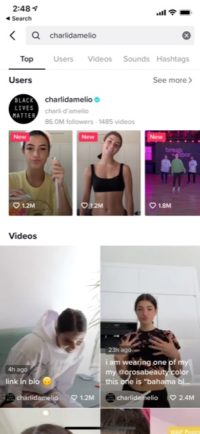You’ve undoubtedly seen news stories about Charli D’Amelio, 2020’s 16-year-old TikTok phenomenon, with 6 billion likes and 82 million followers since she joined the app last spring. It was the part about “automated fame” that really caught my attention in a New Yorker story this past weekend.
 Charli became “the most popular creator on TikTok” partly just because of who Charli is – a very grounded “regular girl” and competitive dancer in suburban Connecticut (that these circumstances are not “regular” to many people, in either racial or socioeconomic terms, is another, very important, story).
Charli became “the most popular creator on TikTok” partly just because of who Charli is – a very grounded “regular girl” and competitive dancer in suburban Connecticut (that these circumstances are not “regular” to many people, in either racial or socioeconomic terms, is another, very important, story).
Before I get to the automated part of her fame, there were/are other factors too, of course. New Yorker writer Cassidy George touched on Charli’s dance skills and easy-going, expressive style ¬– how she adapted those perfectly to TikTok’s format. She also makes dancing look easy, so fellow TikTokers want to join in, and her videos become little tutorials that people keep clicking on to learn a riff and upload their own takes, getting her to those 6 billion+ likes faster and faster. There was the timing too: the convergence of Charli joining TikTok last spring plus all the above plus the pandemic’s arrival in the US, which created exploding demand for lighthearted entertainment in a dark, uncertain time. [A close friend of mine, an oncologist, told me TikTok was her go-to tool of distraction “from the 9 to 5 … it helps to see healthy people doing creative, interesting, funny stuff!”] Then there are her fans, including young TikTok creator wannabes trying to figure out how to replicate her fame – and all the other reasons they follow her.
The automated part
Finally, there’s TikTok’s exceptional algorithm (which the Chinese government is unlikely to allow any would-be TikTok suitor to acquire, but that’s yet another story). The algorithm, part of the “algorithm infrastructure” created by TikTok’s Beijing-based parent ByteDance for all its apps, is the software that “decides” what app users will see when they tap into the app.
 That helped Charli’s popularity explode too, big-time. This is the automated part. Her videos were exactly what the TikTok algorithm “looks for” in its goal to serve up content that makes newcomers feel comfortable with the app and makes all users want to stick around (on average, American users spend 47 min./day on TikTok, according to SupplyGem.com statistics). Charli was the perfect answer to TikTok’s “cold start problem,” reports the New Yorker, referring to newcomers’ first experience of the app. George cites the work of artificial intelligence researcher Marc Faddoul, who describes Charli’s content as a “safe recommendation” for the algorithm to make (“safe,” as in a good fit with “the brand,” which aims to be fun, wholesome and upbeat).
That helped Charli’s popularity explode too, big-time. This is the automated part. Her videos were exactly what the TikTok algorithm “looks for” in its goal to serve up content that makes newcomers feel comfortable with the app and makes all users want to stick around (on average, American users spend 47 min./day on TikTok, according to SupplyGem.com statistics). Charli was the perfect answer to TikTok’s “cold start problem,” reports the New Yorker, referring to newcomers’ first experience of the app. George cites the work of artificial intelligence researcher Marc Faddoul, who describes Charli’s content as a “safe recommendation” for the algorithm to make (“safe,” as in a good fit with “the brand,” which aims to be fun, wholesome and upbeat).
So parents, you can tell your influencer wannabes that that’s part of the equation too – not just looks, talent and finding a unique niche (which is harder now than it was last spring) but also the algorithm.
A different kind of influence
Amid all those reasons for a Connecticut teenager’s TT success, I love that a “regular person” can be a star too.
“Unlike influencer culture, which often conveys unattainable standards of beauty and wealth, TikTok culture reveres ordinariness,” observes Cassidy George. Arguably, we’ve always had “influencer culture,” airbrushing and filters where celebrity’s concerned. But now we have that and regular people. Charli represents an opportunity to see there are upsides as well as downsides to influencer culture. I suspect most kids already know that, but ask yours which influencers they find most interesting and why. They may well point to a regular person with high skill in gaming, sports, music, makeup, math, cooking or just living life well, on TikTok, YouTube, Roblox, Twitch, Snapchat, Instagram, wherever. I bet you’ll learn a lot.
What I hope is, whatever happens next to TikTok in the US (not to mention other societies imposing or threatening bans), people like Charli continue to “go viral” long after the pandemic subsides. The title of her forthcoming book pretty much says it all: Essentially Charli: The Ultimate Guide to Keeping It Real.
Related links
- “Ordinary” to who?: Charli, who’s white and lives in suburban Connecticut, may not come across to people of color with very different life circumstances as “a completely ordinary teenager” (as the Washington Post described her). That’s one of the other important TikTok stories I mentioned above – the one about algorithmic bias. That story was ably reported and told by high school student Charity Grant, in The Oarsman, Venice [Calif.] High School’s award-winning newspaper. She too cites the research of Marc Faddoul but goes into more depth. She quotes Faddoul in an article last February in Wired: “People from underrepresented minorities who don’t necessarily have a lot of famous people who look like them, it’s going to be harder for them to get recommendations…. The platform is very appearance-driven.” So Wired experimented with the algorithm and found that “following a creator who has brown hair and brown eyes will recommend more creators with brown hair and brown eyes…. An account a pet owner set up for their dog produced recommendations for other dog accounts…. Following an 87-year-old man led to three recommendations for three more older men.” This not only happens on TikTok. It’s just that on “a highly visual platform such as TikTok, this applies to how a person looks.” On social media at large, we people follow people whose opinions they agree with. “Algorithms then throw up more of the same content.” Good to know, right? Especially for people interested in being exposed to views and appearances unlike their own.
- YPulse’s latest data on TikTok’s standing with Gen Z: TikTok is No. 1 among US 13-19 year-olds, YPulse found. “Over half of Gen Z is using TikTok, compared to just over a quarter of Millennials. As for Covid-19’s impact, 35% [of Gen Z-ers] were using TikTok in February, compared to 52% in April” (it was during that time that Charli joined TikTok, remember). Their reasons for loving it? They told YPulse because it’s fun, funny and entertaining.
- Influencers for good: See examples of young people’s own cyberbullying prevention work on TikTok in “TikTok: Pros, cons and the promise of youth empowerment,” by Dr. Sameer Hinduja of the Cyberbullying Research Center
- Influencer for coffee: Here’s YPulse on Charli D’Amelio’s new partnership with Dunkin’ with appearances featuring ice coffee in hand in Instagram, TikTok (with a dance challenge) and other social media.
- “Inside TikTok’s killer algorithm,” by Sara Fisher of Axios
- Beijing making it tough: “China prefers TikTok US shutdown to forced sale, Reuters Says,” Ad Age reports. The subhead: “Officials think a forced sale would make ByteDance and China appear weak in the face of pressure from Washington.”
- To her credit, Charli D’Amelio just revealed her struggle with an eating disorder, People reported, quoting what she said in an Instagram story. “I’ve been afraid to share that I have an eating disorder, but ultimately i hope that by sharing this i can help someone else,” Charli wrote.
- Four other teen favorites on TikTok per YPulse
- About social comparison in social media (here in NetFamilyNews)
- Here’s the Washington Post’s piece on Charli D’Amelio

Leave a Reply